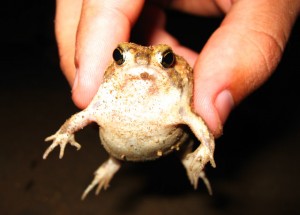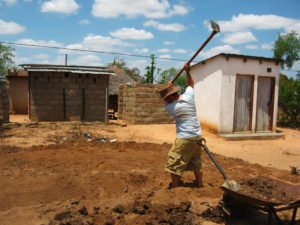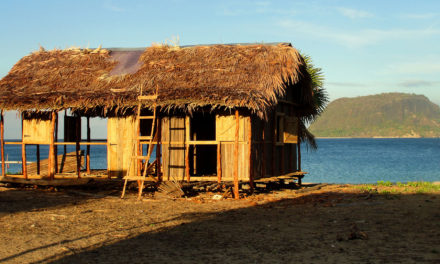For the past six months or so, we’ve been able to go to bed with relatively few disruptions. Few noises outside, and nothing inside the house but us and our two cats.
 About a week or two ago, I stepped outside the house at night and saw one particularly large beetle scurrying across the ground, very distinct because of two large round and bright yellow spots just behind its head. I was a bit surprised because I hadn’t seen this type of beetle, hadn’t seen much of any bugs, for the last six months. But here’s one, obviously a resident of our yard, who re-surfaced after a long absence. In particular, it reminded me that the seasons are changing.
About a week or two ago, I stepped outside the house at night and saw one particularly large beetle scurrying across the ground, very distinct because of two large round and bright yellow spots just behind its head. I was a bit surprised because I hadn’t seen this type of beetle, hadn’t seen much of any bugs, for the last six months. But here’s one, obviously a resident of our yard, who re-surfaced after a long absence. In particular, it reminded me that the seasons are changing.
In America we know the seasons change in a few primary ways: holidays, cold vs. hot weather, and plants blooming. Some even keep track of the changing seasons by the changing school calendar.
But here in South Africa, in the whole Southern Hemisphere, the seasons are pretty much backwards, and are different in other ways as well. So since arriving, and until now, we’ve been working to re-orient ourselves, to come up with a new grasp of the seasons of the year and of life in general.
That’s not always easy when we left the US (in July) and the weather was over 90 degrees there, but less than 40 the next day when we arrived in South Africa. It gets particularly confusing when you know it’s Christmas-time (from looking at the calendar) but the temperature both outside and inside is pushing past 100. Even the school year ends in December and a new one begins in January.
But we’ve been here in one place well over a year now and have been able to make quite a lot of sense of the different seasons. In many ways, the signs of the changing seasons here are more obvious than the ones we remember from the States.
After all, in the States, we often only directly experience the seasons for a few minutes each day, on our way to and from our car, and to and from our work or homes. If the weather is in a perfect balance, we may spend more time relaxing outdoors, but generally we stay inside places where the climate is perfectly conditioned to be the way that we like it – and so the seasons can often pass without us noticing them too strongly.
But in South Africa, not only can we not avoid the changing seasons so easily, they also seem to come with quite a few more indicators of various types. For example, that big beetle with yellow spots reminded me that our nights of un-disrupted sleep have come to an end; when I saw it, I knew what to expect next.
And sure enough, over the last couple weeks we’ve had a plague of annoying “stupid bugs” – some kind of small round generic beetle that likes to fly all around inside our house with apparently no sense of direction and no collision detection. There are dozens of them and they run into the curtains, the walls, our food, us. They land on our seats if we stand up for a split second and then are immediately squashed when we sit back down. They fly directly under our feet as we’re walking. They fly into the oven if we open the door to it. They fly straight into our cats’ mouths (who apparently enjoy them quite a lot). They fly right into our foreheads just as we lie down to sleep.
They’re really “stupid bugs.” Few of them seem to survive each night and Lora sweeps them up each morning, but there’s always plenty more to replace them the next evening. Yet they’ve got their season… they’ll probably only be around to annoy us for another month or so and then they won’t be seen again until this time next year.
But that’s certainly not going to be the end of the bugs. The large yellow-spotted beetle is simply the herald for about six months of this kind of large-scale creepy-crawly activity.
There’s a large variety of cool beetles, large spiders, intricately-patterned moths, and others that hang around for the duration of this time. Of the beetles, there are some dung beetles, some hissing beetles, some rhino beetles, many of them with cool shapes and designs and limited enough in number so as to be more fascinating than annoying.
But many other bugs come in waves. The next large wave is going to be some sort of flying ant/termite sort of thing that’s even more disgusting than the “stupid bugs” and they swarm in the thousands for about a week, discarding their wings (and many of them, even their bodies) all over our porch, to be swept off and blown about like chaff in the wind.
Then after that will come a month or two of locusts – providing a supplemental food source to many in our village. It’s also the emerging “mopani worm” season right now, a sort of caterpillar delicacy that can be easily found on large trees, and either some love to eat them or others hate them. (Personally, I just think they’re bland and the texture’s disagreeable.)
 And all during this time, beginning just last week, the frogs come out at night. They’re usually out every night, croaking loudly, but they’re loudest immediately after rains have come. Though their ruckus can be annoying, we generally appreciate them – after all, what else is going to put a dent in the hordes of bugs during this time? Not only that, but one type that likes to live around here, called a “rain frog” (but which we refer to as “marshmallow frogs”) is pretty cute – it’s a small fat marshmallow-y ball of a frog with short stubby hind legs, so that it waddles across the ground instead of hops.
And all during this time, beginning just last week, the frogs come out at night. They’re usually out every night, croaking loudly, but they’re loudest immediately after rains have come. Though their ruckus can be annoying, we generally appreciate them – after all, what else is going to put a dent in the hordes of bugs during this time? Not only that, but one type that likes to live around here, called a “rain frog” (but which we refer to as “marshmallow frogs”) is pretty cute – it’s a small fat marshmallow-y ball of a frog with short stubby hind legs, so that it waddles across the ground instead of hops.
There’s no way we could deny that winter is over here and summer is quickly upon us. And no doubt summer’s constituency will progress through their phases this year just like we saw them do last year.
But the bugs and other animals aren’t the only signs of the times. Of course it’s getting hotter FAST! That’s another thing that can make it more difficult to sleep at night and more difficult to stay awake during the day. Another Volunteer likes referring to the “heat-induced narcolepsy” of this time of year.
But other seasonal signs are more obvious in how they impact the community as a whole. This is the time of year when the river’s becoming dry, the wells are empty, and even our school’s deep borehole is pumping only dust. Last year, we thought we were at the edge of a crisis, but now we know it’s common to run into this dry spell at the end of winter and the beginning of summer while we wait for the rains to come and for the water table to be replenished.
And some seasons are just for that: waiting. But a person can wait expectantly, and everyone eagerly states that the heavy rains are coming soon. We’ve been lucky to have a few light rains in the last week already and some (including us) have collected the water run-off from our roofs while we wait for the rest of the water to trickle down into the earth and refill the wells and boreholes. Even as I type this, I can hear thunder in the distance, so maybe today’s the day for the start of heavy rains here.
Even in our work, we’re going through the seasons. The recently finished Term 3 at our schools was very productive for both of us – in some ways the culmination of many of our efforts, and also the beginning of some new ones.
But from last year, Lora and I have known that this term, Term 4 – the last of the school year, is a term of almost zero productivity. When we’ve gone through cycles of “uselessness” (or at least, inability to work as we wish) in the past, it’s been easy to be disappointed. But we’ve come into this term expecting disruptions to our work and neither us nor our expectations have been disappointed.
 Instead, we’ve found other things to do: I’ve been busy preparing a garden based on new methods I’ve recently learned, and Lora’s been finding time to try to integrate better into the community by washing our clothes down at the river with the rest of the ladies. (That one’s kind of a necessity since it’s the only place remaining with much water anyway.)
Instead, we’ve found other things to do: I’ve been busy preparing a garden based on new methods I’ve recently learned, and Lora’s been finding time to try to integrate better into the community by washing our clothes down at the river with the rest of the ladies. (That one’s kind of a necessity since it’s the only place remaining with much water anyway.)
It’s also the same time the rest of the community is beginning to hoe the ground, preparing it for the rains that will surely come any time now. And in a week or two, maize seeds and peanuts will be sown into the ground. A few weeks after that should see their sprouts sticking an inch or two above the fresh soil. And a few months after that, they should be ripe for the harvest. Everything has its season.
I think the author of Ecclesiastes must’ve lived in a situation more like this one, one where the passing of seasons and their accompanying signs is more direct and life-affecting than we’re used to experiencing in America. Certainly what’s written in Ecclesiastes 3 : 1 – 8 rings all the more true to us with our experiences here. “For everything there is a season, and a time for every matter under heaven.”
Because of course, there are other seasons too, many of them much less tangible. Initially, we were pretty clueless and lost when we showed up here – completely out of our comfort zones, very few accurate expectations of life here or the people around us. It was a season of new beginnings and fledgling starts, of mistakes and lessons learned.
But right now we’re feeling pretty well adjusted culturally. We’re comfortable with things here, we have a good idea of what to expect in many areas, we’re becoming better at our work, knowing how to navigate the systems here that before were only obstacles. Soon, it feels too soon really, will be a season for good-byes and leaving.
But like all seasons, even these will continue to be repeated year after year. After our season of good-byes will be a season of readjustment to living in the US. That one may not last long though, followed by a totally new season of adaptation to life in Madagascar. And at some point there in Madagascar we should expect to enter the same season of cultural well-adjustment that we’re in now. And then no doubt at least some aspect of our work will change, we’ll find ourselves in some new community, and the cycles of seasons will start all over again.
I think there’s some reassurance in the repetition of these seasons. Maybe the main reassurance is that we know what to expect. It’s true that not every season is a pleasurable one. There’s a time to laugh, but also a time to cry. There’s a time for mourning, a time we’ve surely experienced often here, deaths and funerals never decrease in frequency.
 But there’s also a time for dancing, plenty of it here, and maybe the dancing is all the more energetic and enjoyed because it follows so closely upon the time of mourning. A person mourning the death of an immediate family member traditionally “wears the black clothes” for a full year. At the end of the year, a celebration is held for “taking off” the black clothes and the celebration is usually highlighted by a day full of traditional dancing.
But there’s also a time for dancing, plenty of it here, and maybe the dancing is all the more energetic and enjoyed because it follows so closely upon the time of mourning. A person mourning the death of an immediate family member traditionally “wears the black clothes” for a full year. At the end of the year, a celebration is held for “taking off” the black clothes and the celebration is usually highlighted by a day full of traditional dancing.
The same way there’s usually a funeral every Saturday somewhere in the village, there’s also usually a “taking off” celebration with mchongolo dancing every Sunday somewhere in the area. So while mourning may be all that’s visible one day, another day of dancing and celebration can surely be expected to return.
With every time for being born, there also follows a time to die, to be expected and not to be escaped. But for every time of breaking down, there follows a time for building up. Even as the ground is broken and smashed by the hoe before the rains come, a seed is dropped in which then springs to life, rises quickly and multiplies, and spreads new life to those around. And with the seasons, both those we desire and those we don’t, we can see the signs of their coming.
So bad times are followed by good times. And with a good God, can we not surely expect that the good times, when they come, will be so much better than the bad times are bad?
In Romans, this applies to the whole of Creation: “I consider that the sufferings of this present time are not worth comparing with the glory about to be revealed to us. For the creation waits with eager longing for the revealing of the children of God… in hope that the creation itself will be set free from its bondage to decay and will obtain the freedom of the glory of the children of God.” (8:18-19,21)
In Revelation, there’s a long description of breaking down and destruction of everything, of entirely putting an end to the seasons we know. But this is their end: “Behold, I am making all things new!” (21:5)
So the seasons themselves are a reminder to us that after the winter destroys, the spring arrives and brings life. And one day a final winter will bring an ultimate and eternal spring. Jesus on the cross took death to its grave and then rose again to bring final life to us all. I’m thankful that little yellow-spotted beetle reminded me of this.




